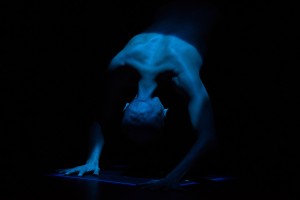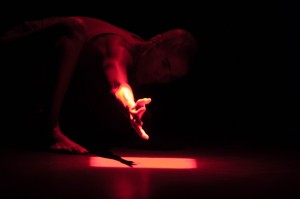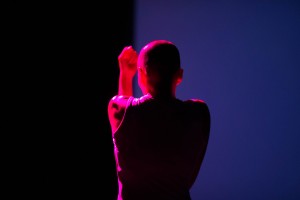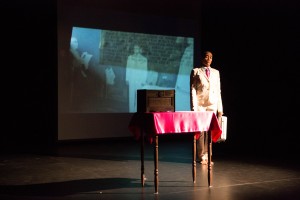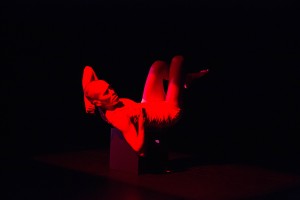Photos: Frank Chen
Intertwining Roots is a multimedia solo performance incorporating material gathered through Otálvaro-Hormillosa’s fieldwork in Argentina concerning the Dirty War (1976-1983) and archives of her Filipino grandfather who worked as a diplomat in Buenos Aires during Juan Peron’s term in the late 40s and early 50s. Her quest for him and research about the disappeared are intertwining processes of memory recuperation.
A work in progress of the performance was presented at Galería de la Raza in San Francisco in the fall of 2013 with support from the National Association of Latino Art and Culture. The official premiere of the performance took place at the Nitery Theater at Stanford University in February of 2015 with support from the Department of Theater and Performance Studies.
May 2015
Excerpts from the 2015 Stanford Theater and Performance Studies Department Newsletter Article about Intertwining Roots by Gigi Otálvaro-Hormillosa
In February of 2015, I presented Intertwining Roots, a solo performance that I conceived, wrote, performed, and directed at Stanford University’s Nitery Theater. Intertwining Roots was the culmination of my scholarly and performance research about Argentina’s Dirty War (1976-1983) and my grandfather Juan Hormillosa. The research process began in 2011 while I was completing my M.A. in Visual and Critical Studies at California College of the Arts, where I first learned about this historical catastrophe which became the topic of my thesis. I traveled to Buenos Aires where I connected with key figures in various human rights organizations, such as the Argentine Forensic Anthropology Team (EAAF), the Grandmothers of the Plaza de Mayo, and The Space for Memory Institute which oversees the recuperation of former torture centers all over the country. Prior to my trip to Argentina, I began to recall that my grandfather from the Philippines spent a significant amount of time of his career as a consul in Buenos Aires during Peron’s first term. I contacted the Filipino Embassy there to find out if they had any information about him. Thus began the intertwining of roots, of both my South American heritage and Filipino heritage.
For the solo performance I premiered at the Nitery, I developed vignettes based on my research about my grandfather, the detained pregnant women, their mothers, their stolen sons and daughters, and the role of the Argentine Forensic Anthropology Team (EAAF) in uniting family members. The central vignette incorporated text from a piece I wrote entitled “Thanksgiving” in which I detailed my visit to the offices of the EAAF (on Thanksgiving Day). When I first wrote the piece several years ago, I knew that I would eventually make a performance about it, but I also realized that it would take time to process and assimilate this profound experience—my encounter with human remains of the “disappeared.” It changed my life by forcing me to think about corporeality in ways I had never considered.
One of my primary intentions with the work has been to educate audiences about an aspect of Latin American history (one in which the U.S. was implicated as with many other dictatorships in the region before, during, and after that time) and to do my part in catalyzing an awareness of the political privilege that so many of us take for granted: the privilege of not having to live with the psychological torture of having had a loved one disappeared. My hope is that the work encouraged people to empathize with others by contemplating their own corporeality—their flesh and bones, as I began to do as a result of my fieldwork.
At the level of conceptual and design choices, I was also impacted by my exposure to Abstract Expressionism during a seminar I took in the fall quarter. The art critic Harold Rosenberg described Abstract Expressionism as “action painting” whereby artists approached the canvas as an arena in which to act. They experimented with scale, large gestural brushstrokes, and the negation of figuration and narrative, though some of these artists incorporated abstraction and figuration into their works. Thus I was inspired to create an abstract performance, but I was also committed to balancing abstraction with narrative and concrete details—with figuration so to speak. Inversely, I treated the stage as a canvas on which to paint, experimented with scale (i.e., performing in tightly lit small spaces on stage), and sought ways of negating the body, or what is expected of the performing body on stage. I envisioned “Thanksgiving” as a process of negation in which my back would almost always be facing the audience. The goal was to articulate my bones and flesh as a way to visually and physically manifest the story about my encounter with human remains at the EAAF.
As with many Abstract Expressionists, I also allowed the work to be informed by my unconscious, my dreams, and gestures that simultaneously incorporated control and spontaneity. Since I didn’t have full access to the lights until production week, I was pleasantly surprised to see how additional shapes were surfacing from the shadows created by the lights. In that sense, I achieved an aspect of my goal to create an abstract work that simultaneously incorporated controlled, choreographed movements with the spontaneity of imagery that emerged from the interplay between spirit, flesh, light, and shadow. As a result of this piece, I have developed a deeper appreciation for lighting and its potential to enhance live performance, and will continue to explore these relationships between light, flesh, and movement in future work.
In addition to video documenting myself as a way to direct myself, I was fortunate to have key individuals help me shape the piece from the start, beginning in the fall quarter. I am grateful and honored to have had the opportunity to share the stories of the “disappeared” with the resources and support provided by the Theater and Performance Studies Department at Stanford and hope that the work touched the hearts and minds of the audience despite what may seem like a wide temporal and geographic divide between the U.S. in the twenty-first-century and the Latin America of the late twentieth-century.

